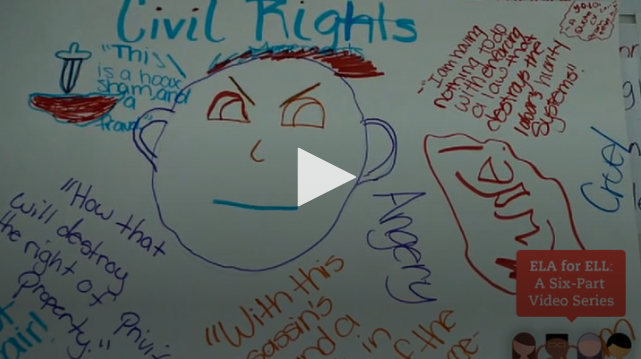Differentiating language for English Language Learners (ELLs) while delivering grade-level content can be a challenge. Here are some tips for scaffolding language for your language learners, while ensuring your important content objectives are met simultaneously.
Keep your visuals, graphic organizers, and color coding the same for each lesson and content area.
When using Venn Diagrams, keep your color coding the same for each lesson and content area. If your ELLs are always looking for similar or like items to be red, and unlike or different characteristics to be blue, you can carry this thread through your sentence frames and writing models.
Make sure to always include a visual picture with your graphic organizers. In this video, you’ll see ideas for visual supports for pre-K students that will help ELL students of all ages to be successful in your classroom. When your ELLs aren’t working so hard to remember what each term is, they’ll be more able to focus on the content you’re trying to deliver.

Highlight words that you’ll repeat continuously with color-coded boxes.
When you’re delivering lessons, highlight the words you use in sentence frames repeatedly. This gives your ELLs a point of reference and a connection to previous lessons. The more you can highlight the similarity or compare and contrast through various contexts, the more it will help your students focus on new content and give them context for repeated vocabulary.
Always give your students the opportunity to tap into previous knowledge.
Your ELLs bring so much background knowledge to the table. Tap into their previous learning and give them a chance to share their schema. They can do this in any language. Provide your students with the opportunity to share what they already know in one color and add their new learning in another. In this video, Emily Park-Friend shares ideas on how to tap students’ prior knowledge.
Be sure to allow the use of visuals, drawings, and diagrams in schema development — it’s a chance for your students, especially your language learners, to shine!

Take the time to correct misconceptions.
Sometimes students will share incorrect information. This is a great opportunity for learning. Structure your lessons so your students can discover their mistakes on their own and move prior thoughts into a “misconception box.” All of these new words are great for vocabulary development and will serve to help your ELLs in the future.
Sentence frames are your best friend.
When ELLs have the opportunity to use similar sentence frames over and over again, they’re able to focus on content rather than language.

In the example above, kindergarten students who became familiar with the words “similar” and “different” were able to transfer these tier two vocabulary words into their next non-fiction animal study texts. This video demonstrates how ELLs benefit from the language support needed to answer content-related questions.

Language learning is complex. When you structure your lessons to give your ELLs repeated exposure to language scaffolds and vocabulary across many content areas and contexts, you build connections that transfer into long-lasting language mastery.
Aim for consistency in your scaffolding and watch your ELLs language development bloom across all content areas.
How do you use visual scaffolding with ELLs — and all students — in your classroom?






